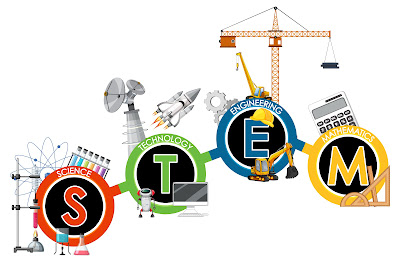 |
| Image by brgfx on Freepik |
In Part 1 of this series I cautioned against the recent prioritization of the "T" in STEM, and in particular the extreme focus on coding I've observed in the last few years, which seems to imply that everyone must learn coding to be successful or that coding knowledge guarantees success; neither of which is true. I advocate for a more well-rounded approach, exposing kids to all areas of STEM. I'd like to follow-up with some general considerations when doing STEM activities, ways to incorporate STEM elements into other programs, a brief discussion of STEM vs. STEAM, and a few resources.
STEM has become one of the trendy buzzwords in both the education field and in library programming, and anytime something becomes an industry buzzword, it tends to be overused and misused, and STEM is no exception. I've seen programs and activities labeled as "STEM" that really didn't include any STEM, or that presented factually inaccurate information and examples. For example, slime programs might be considered a science program, but only if you talk about what polymers (the glue) are and how the borax makes it turn into slime by cross-linking the strands of glue. Another example, an attempt to convert a snowflake craft into a STEM activity by talking about how snowflakes have symmetry, but then the example provided showed 4-pointed snowflakes; the factual inaccuracy negates its STEM value.
Here are some things to keep in mind when planning STEM activities:
- It's the PROCESS, not the product!
- Let the kids do as much themselves as possible.
- "Failure" is an opportunity for critical thinking and problem solving.
- Be sure you are highlighting and explaining the STEM principles involved.
- Be sure you are presenting accurate information!
- Test only one variable at a time.
- Invest in basic equipment/supplies with multiple uses
- measuring cups, spoons
- kitchen scale
- thermometers
- hot plate
- craft sticks
- disposable pipettes
- open-ended building sets
- Do your research before buying expensive gadgets, be sure they're appropriate for the intended age and goals
- Partner with other libraries to share more expensive equipment
- If you're on a tight budget, baking soda & vinegar are your friends!
- Counting, adding, subtracting, and other calculations
- Measuring
- Graphing
- Grouping/Sorting
- Patterns
- Making observations
- Making predictions
- Including factual information, such as non-fiction books in storytime or book clubs
- Building (blocks, bricks, magnetic tiles, etc.)
- Point out the STEM in art, cooking, and other activities.
- Encourage kids to ask questions and to find or figure out the answers
- Open-ended activities, such as process art, loose-parts play
- Multidisciplinary programs combining arts/crafts, STEM, motor, and sensory activities
- Including STEM careers in career days/fairs
I tend to use STEM most of the time, partly because it came first and partly because I am a science person. I generally use STEAM only when I'm doing a program that really does combine art and science, but I do tag my posts with both acronyms to be sure they can be found regardless of which acronym someone is searching with. Many people use them fairly interchangeably. Here are a few programs I've done that I would call STEAM because they either considered the science involved in an art technique, used science/tech to create art, included an artistic/creative component, or was a multi-disciplinary program with multiple activity stations:
- Doodlebots - can be creative in designing their appearance, and used to create art
- Snowflake Science - made snowflake art with cotton swabs, as well as resist art
- Spy School - used resist art to make and reveal hidden messages
- Paper Circuits - used paper circuits to add light effects to artwork
- Mini Gingerbread Houses - Design, build, and decorate a gingerbread house
- Kaleidoscopes - artistic creativity in creating patterned disks to view
- DNA Extraction - made candy and origami DNA models
- Dinosaurs - a multi-station program with STEM, art, and sensory elements.
- "Programming Librarian" Facebook group & website
- "STEAM Library Ideas" Facebook group (not a lot of members or very active)
- "STEM in Libraries" Facebook group (not well-moderated, lots of spammy posts)
- NASA sites
- Frugal Fun for Boys and Girls
- Little Bins for Little Hands, STEM and STEAM
- STEM in Libraries blog
- The Show Me Librarian blog
- Other librarian, teacher, and homeschool blogs
- Museum websites
- Your shelves! Science project books in the 500's
- Google - Pick a topic, and search “(topic) STEM/STEAM activities for (age group)”
- This blog! Adventures In Storytime (and Beyond)



No comments:
Post a Comment